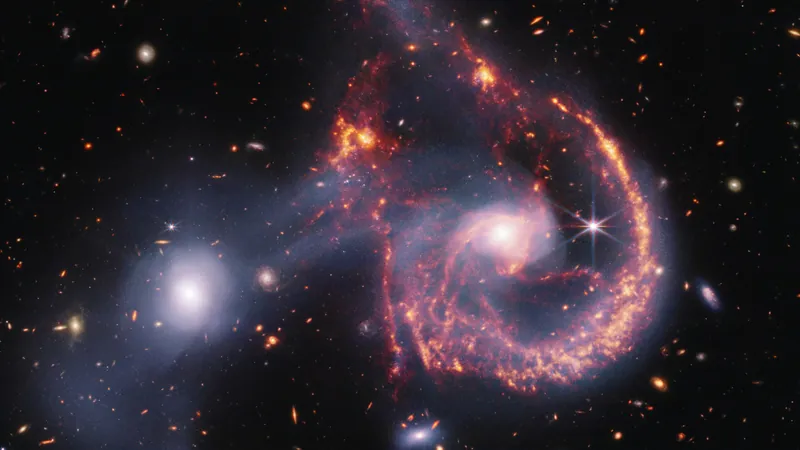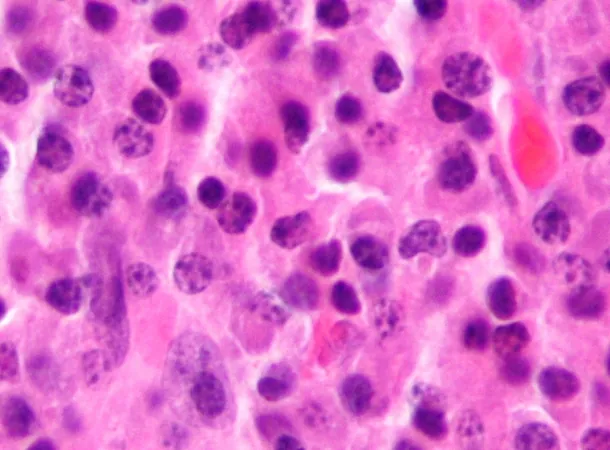
A 'Smiling' Galactic Collision Captured by the James Webb Space Telescope! Discover the Cosmic Drama!
2024-09-19
Author: Nur
A 'Smiling' Galactic Collision Captured by the James Webb Space Telescope! Discover the Cosmic Drama!
Using the state-of-the-art James Webb Space Telescope (JWST), astronomers have made an astonishing discovery: a cheerful-looking galactic collision! This captivating merger involves a large spiral galaxy and a smaller elliptical galaxy, collectively known as Arp 107, located approximately 465 million light-years away in the constellation Leo Minor.
The impressive $10 billion JWST utilized its advanced NIRCam (Near Infrared Camera) and MIRI (Mid Infrared Instrument) to capture stunning images of Arp 107. What caught the attention of scientists and stargazers alike was a nearly transparent white "bridge" of stars—material that has been torn from both galactic bodies during their tumultuous encounter. Bright areas of star formation, depicted in vibrant shades of orange and red, come together to form a striking smiley face among the stars!
The spiral component of Arp 107 is classified as a Seyfert galaxy, which is part of a large group of "active" galaxies renowned for emitting substantial amounts of energy from their centers. The most luminous of such galaxies often host supermassive black holes, known as quasars. Seyfert galaxies, named after American astronomer Carl K. Seyfert, are notably dimmer than quasars, making them easier targets for observation in low-energy light, such as the infrared that the JWST specializes in.
Interestingly, while there are similarities between Arp 107 and other interacting galaxies like the Cartwheel Galaxy, Arp 107 exhibits a distinctly different appearance. This difference stems from the smaller elliptical galaxy being off-center during its collision with the larger spiral galaxy. As a result, the spiral galaxy largely retains its structure, with only its characteristic spiral arms being nearly obliterated.
Galactic collisions like the one witnessed in Arp 107 can be a double-edged sword when it comes to star formation. For galaxies that aren't actively forming stars, these mergers can introduce new reservoirs of gas, which are essential building blocks for star creation, compressing it into dense regions ideal for stellar births. Conversely, the JWST has also observed how such collisions can disperse gas, stripping galaxies of the necessary ingredients for new star formation.
The ongoing collision in Arp 107 is expected to unfold over hundreds of millions of years. Once completed, researchers believe that the two galaxies will merge into a larger, irregularly shaped galaxy—an astronomical transformation that underscores the dynamic and ever-changing nature of our universe.
Stay tuned for more astonishing discoveries from the James Webb Space Telescope as it continues to unravel the mysteries of the cosmos!

 Brasil (PT)
Brasil (PT)
 Canada (EN)
Canada (EN)
 Chile (ES)
Chile (ES)
 Česko (CS)
Česko (CS)
 대한민국 (KO)
대한민국 (KO)
 España (ES)
España (ES)
 France (FR)
France (FR)
 Hong Kong (EN)
Hong Kong (EN)
 Italia (IT)
Italia (IT)
 日本 (JA)
日本 (JA)
 Magyarország (HU)
Magyarország (HU)
 Norge (NO)
Norge (NO)
 Polska (PL)
Polska (PL)
 Schweiz (DE)
Schweiz (DE)
 Singapore (EN)
Singapore (EN)
 Sverige (SV)
Sverige (SV)
 Suomi (FI)
Suomi (FI)
 Türkiye (TR)
Türkiye (TR)
 الإمارات العربية المتحدة (AR)
الإمارات العربية المتحدة (AR)